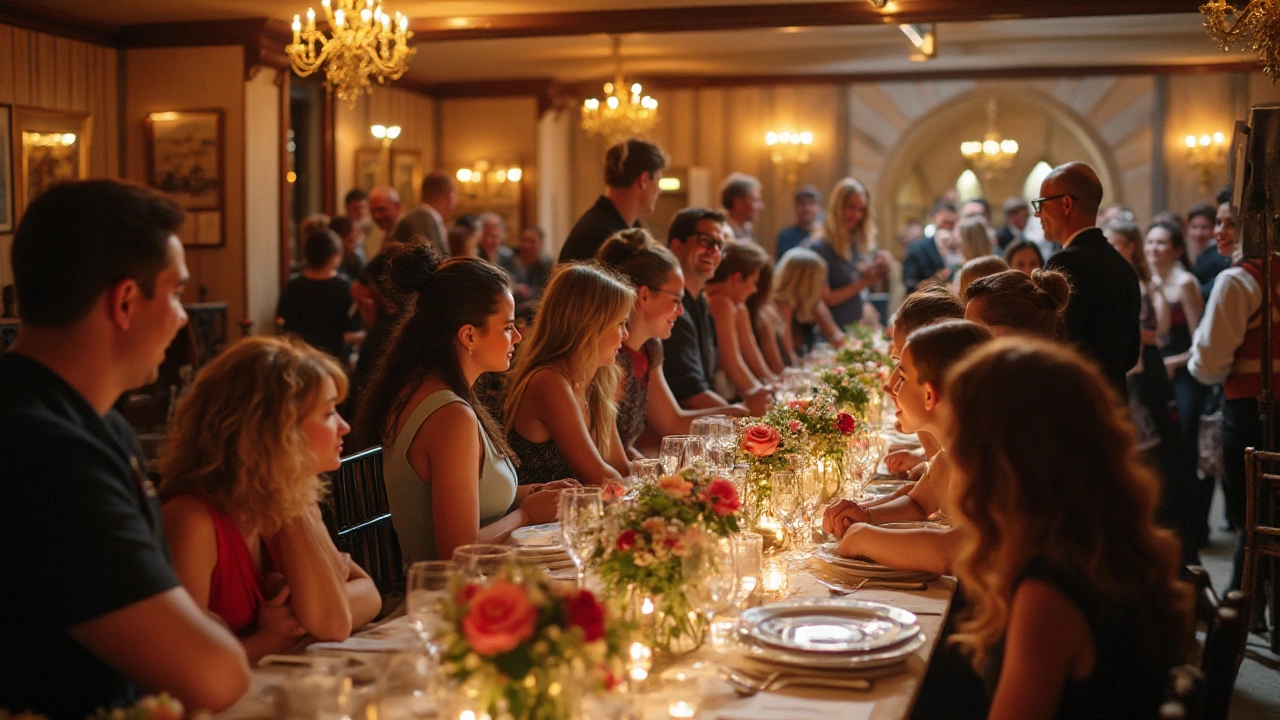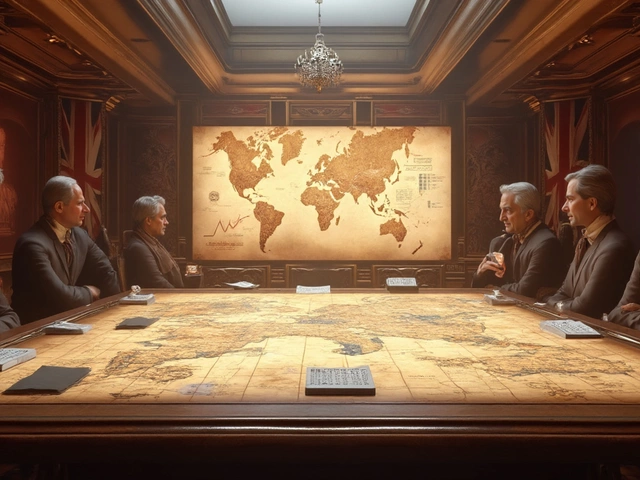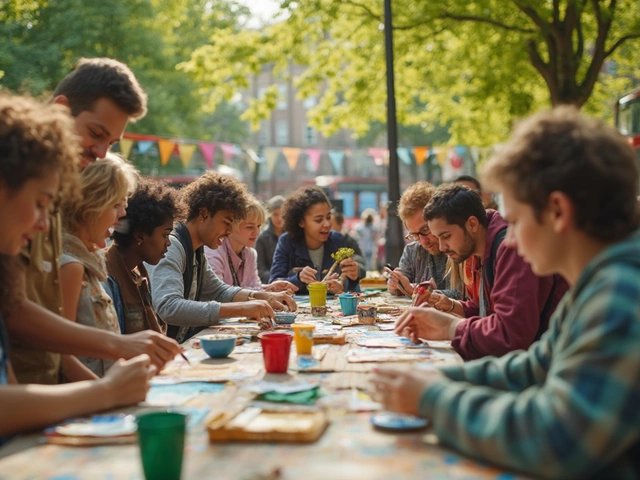Guide to Hosting a Memorable Charity Event
Organizing a charity event is no small task, yet it has the power to make a tremendous difference. At its heart, a successful charity event combines great passion with meticulous planning.
To start, it's crucial to have a clear goal—knowing what you're working towards helps in creating a focused strategy. Engaging the right audience is equally as important. Not just any crowd, but the crowd that aligns with your cause and shares your enthusiasm.
Think outside the box when it comes to fundraising ideas. Innovative activities can spark interest and encourage donations, making it more than just a typical gathering. Plus, with a robust marketing plan, you can spread your message far and wide, drawing in support from unexpected places.
Attention to detail ensures that the event runs smoothly, and afterward, following up with attendees and supporters can solidify their relationship with your cause, paving the way for future support. A well-executed charity event doesn’t just end at the closing speech; it leaves a lasting impact that can resonate for months or even years.
- Setting Clear Objectives
- Understanding Your Audience
- Unique Fundraising Ideas
- Effective Marketing Strategies
- Attention to Detail
- Post-Event Engagement
Setting Clear Objectives
The first step in crafting a successful charity event is setting clear and achievable objectives. Without well-defined goals, it can be difficult to measure your success or maintain the enthusiasm of your team and supporters. Having specific aims will guide your decisions, influence your event’s theme, and help identify the resources you’ll need to gather along the way. It’s essential to recognize whether you are looking to raise a certain amount of funds, increase awareness for a cause, or entertain and build a community.
Begin by pinpointing what your charity event hopes to achieve. Is it purely about raising funds? Perhaps the focus is to spotlight an overlooked issue like local homelessness or a rare disease. Metrics, such as the amount raised or the number of new donors acquired, offer tangible benchmarks which make it simpler to evaluate the event afterwards. Author and fundraising expert Gail Perry emphasizes, “Fundraising is not really about the money. It’s about helping and changing lives.” Such a perspective reminds us to keep the human touch in mind, as we plan the logistics.
Consider breaking down the event objectives into short-term and long-term goals. Short-term goals could include immediate fundraising targets, while long-term goals might focus on increasing visibility and establishing sustainable support for future endeavors. A table listing these objectives with corresponding deadlines can serve as a roadmap and ensure nothing gets missed. For instance:
| Objective | Description | Deadline |
|---|---|---|
| Fundraising Target | Raise $20,000 for local school supplies | Event Date |
| Awareness | Engage 500 new social media followers | One Month Post-Event |
Articulating these goals not only aids your team's focus but also allows potential donors and sponsors to understand the event’s purpose and where their contributions will lead. Clear objectives act as a foundation, aligning everyone involved towards a common cause. They allow you to paint a vivid picture, one where supporters can see the direct impact of their involvement. With clarity in your objectives, you’ll find it easier to communicate with all parties involved—from the volunteers who help run the event to the local community whose participation is crucial.
Understanding Your Audience
Identifying and comprehending your audience is a critical step in orchestrating a successful charity event. Knowing who they are isn't just about demographics; it's about delving into what drives them, what they care about, and what might inspire them to invest their time and resources into your cause. Start by creating a profile of your ideal attendee. Consider factors like age, interests, values, and community involvement. Are they environmentally conscious millennials, dedicated to sustainable practices? Or perhaps seasoned philanthropists, with a history of supporting educational initiatives? These insights not only shape your outreach strategy but also influence the tone and style of your event presentation.
One effective method to gain insight into your audience is through surveys or focus groups. Ask potential attendees directly about what they would like to see in a charity event. This can provide invaluable feedback and ideas that align with their expectations. Furthermore, observe the types of events they attend and how they engage with similar causes. For example, a survey by the National Center for Charitable Statistics highlighted that millennials are most likely to engage with interactive donation platforms and events, preferring experiences that offer engagement and visibility.
When understanding your audience, it is also beneficial to look into their preferred communication channels. This knowledge will allow you to tailor your marketing efforts effectively. Whether it's through social media, email newsletters, or community events, reaching them where they are most active can dramatically increase your outreach success. Local community boards, social networks, and even lifestyle blogs often serve as hubs where potential attendees gather. Use these platforms to convey your message.
Engagement and Personalization
Engagement is a fundamental aspect of any fundraising initiative, and personalization can go a long way in making your audience feel valued. Once you acquire a detailed understanding, you can start to craft personalized communications. Instead of generic invitations, consider sending tailored messages that connect with their personal interests or previous interactions with your cause. For instance, if certain attendees have shown interest in educational causes, highlight how their participation can directly impact literacy programs. A study conducted by the Stanford Social Innovation Review suggests that personalization in fundraising can increase positive response rates by up to 64%. This approach not only boosts engagement but also fosters a sense of belonging among your audience.
"Engaging with your audience on a personal level makes them feel like they are part of the solution. They're not just attending an event; they're participating in a movement." – John Haydon, Author of "Facebook Marketing for Dummies"
Furthermore, consider incorporating storytelling into your engagement strategy. Sharing real-life stories related to your cause can resonate deeply with your audience. Humans are naturally empathetic, and stories can often evoke emotions and drive actions more powerfully than statistics alone. Regardless, combining the two can be particularly effective. For example, if your event supports clean water initiatives, pair impacted community narratives with data on water quality improvements.

Unique Fundraising Ideas
When it comes to hosting a sensational charity event, innovation can be your greatest ally. Embracing unique fundraising ideas not only captivates your audience but also provides fresh avenues for backing your cause. Today's attendees are not just passive participants; they seek experiences that resonate deeply with their passions. Take the concept of a bespoke 'Dinner in the Dark' event, where guests are blindfolded. This heightens their other senses and builds empathy for the visually impaired, all while enjoying a gourmet meal. Such an experience truly makes the dinner a memorable one, leaving attendees with a deeper connection to the cause.
Another idea gaining traction is the concept of a 'Reverse Raffle.' Unlike traditional raffles where the first name drawn wins, here, the last name drawn gets the prize. This keeps participants engaged for longer periods during the event. You might think about enhancing this by offering small consolation prizes throughout the raffle to keep spirits high. Engaging technology-savvy individuals with a virtual reality (VR) experience related to your cause is yet another innovative approach. Imagine transporting participants to a different reality—be it exploring an endangered habitat or understanding life in an underprivileged community. Such experiences leave an indelible impression and strengthen the call to action.
For those interested in physical activities, a 24-hour charity streamathon could be the answer. Combining gamers' zeal with a purpose, you can engage both casual and hardcore gamers in raising funds through playing their favorite games. Participants can challenge others to donate in exchange for completing certain in-game feats. This not only widens your event's reach but adds an engaging competitive element. This digital format also opens doors to global participation, breaking geographical barriers.
The Association of Fundraising Professionals suggests, "Incorporating a digital component in your events can increase your reach by up to 30%, engaging an audience beyond traditional means."Moreover, a charity fashion swap capitalizes on the eco-conscious trend of recycling clothes. Invite participants to exchange their gently used attire, all while supporting your fundraiser. Offer styling tips and make the event a fashion-forward affair. This strikes a chord with sustainably-minded individuals and gives them a chance to contribute to a cause they care about while refreshing their wardrobe.
In the realm of standout accessibility, consider a 'Text-to-Give' initiative at your event. With most donors already tied to their mobiles, a simple, immediate option for donation can prove powerful. This aligns seamlessly with effective marketing strategies that pull at the heartstrings. If your event spans multiple niches, catering to diverse groups with tailored entertainment options could also work wonders. Offer an art auction, live performances, or even a craft beer tasting—variety keeps it fresh and enticing.
| Event Concept | Potential Reach | Engagement Level |
|---|---|---|
| Dinner in the Dark | High | Immersive |
| Reverse Raffle | Medium | Interactive |
| VR Experience | High | Transformative |
| Charity Streamathon | Global | Digital |
Ultimately, what sets your charity event apart is its personal touch and the specific way it connects with guests. By weaving creative concepts with a passion for your cause, you ensure that giving becomes an experience rather than just a transaction. As such, remember that the most successful events are those that linger in the memory, fostering a lasting commitment to your cause.
Effective Marketing Strategies
Promoting a charity event effectively involves a mix of creativity and strategy, ensuring that the message not only reaches a broad audience but also resonates deeply with them. At the core of a successful marketing campaign is strong storytelling. Your cause may involve numbers and logistics, but it is the human element—the real stories behind why the event matters—that will emotionally engage your audience. Craft narratives that highlight personal stories of individuals impacted by the charity, and use these in your promotional materials, both online and offline.
Utilizing social media platforms is crucial in today's digital era. Tailor your content for different audiences and platforms, whether it’s an Instagram reel that captures the spirit of your charity gala or a detailed Facebook post introducing the event’s mission and the people behind it. Be sure to incorporate interactive content such as polls or live Q&A sessions that can foster engagement. Social media thrives on interaction, and engaging directly with potential attendees can significantly boost interest and attendance.
"The broader our outreach, the greater our opportunity to ignite the spark of compassion and action in potential supporters," remarked Susan McPherson, a prominent voice in the philanthropy sector.
Another strategic approach is leveraging email marketing. Personalized emails can effectively convey important details about the fundraising initiatives and any unique activities your event will feature. Segment your audience based on their previous interactions with your charity to ensure your messages are relevant and impactful. This personalized touch not only increases the likelihood of people attending the event but also promotes long-lasting relationships with your donors.
Traditional marketing should not be overlooked. Consider targeted press releases and collaborations with local media outlets. Appearing in community bulletin boards or local newspapers might seem old-school, but such channels often have a trusted relationship with the readers who are likely to be long-term residents with a vested interest in local affairs. Utilize flyers and posters at strategic locations, such as community centers, to tap into this potential audience.
A mix of both digital and traditional marketing techniques ensures that your charity event reaches a wide spectrum of potential attendees. Use tailored strategies to reach different sections of your audience, keeping the essence of your event clear in all materials: it’s about creating change through collective effort.
Finally, mobilize influencers or local figures who are active within your community. These personalities can lend credibility and expand your reach exponentially. Events that incorporate the goodwill and visibility offered by influencers often witness a surge in attendance. As the event approaches, maintain momentum with timely updates and a countdown, ensuring excitement remains high until the day of the event.

Attention to Detail
The saying “the devil is in the details” rings particularly true when it comes to organizing a charity event. It’s the little things that often determine the success or failure of such an undertaking. From ensuring that the venue is accessible to all attendees to confirming that the AV equipment is in full working order, much goes on behind the scenes. Each detail plays a significant role in shaping the guest experience and meeting the event’s objectives. To begin, consider the overall flow of the event. How will guests move from one area to another? Are there sufficient clear signage and directions for different segments of the event, such as speeches, dining, and auction areas? Engaging with a venue manager who can offer insights into site logistics might tremendously ease this process. Attention to these particulars helps distinguish a well-executed event from a chaotic one.
Another critical aspect to hone in on is timing. The punctuality of each part of the event is crucial. Whether it's the main speakers starting on time or meal services being efficiently managed, timing is everything. A smoothly run schedule reflects your respect for the attendees’ time, increasing the value they perceive in supporting your cause. To ensure this, have a dedicated team or personnel overseeing the schedule, equipped with tools like stopwatches or event timing apps to maintain precision. It's not just about starting every session on time but also ensuring you have buffer times to account for unexpected delays. Relying on volunteers or staff who have prior experience can be beneficial here. As Bob Woodruff wisely noted, “Planning is bringing the future into the present so that you can do something about it now.”
The ambiance and decor form another layer of detail. This encompasses the event's aesthetic—centerpieces on the table, lighting, and audio—all of which contribute to the event's atmosphere, making it memorable. Choose a theme that resonates with your cause and ties it all together with the right decor. Consider different sensory details, such as using music to subtly underscore different points in the event. Hiring a band or DJ who understands the event's tone contributes to the overall success. There are statistics to suggest that well-lit and atmospheric decor increases attendee satisfaction by up to 30%, which might in turn boost donation levels, a vital component of any fundraising. Familiarizing yourself with these nuances can transform how people perceive and interact with your event.
Finally, don't overlook the importance of communication. Ensure that everyone involved in the event—from organizers to volunteers—knows their roles and responsibilities. Miscommunication can lead to blunders that could have been easily averted. Organizing a brief meeting or sending out a detailed instruction manual with team roles and timelines ensures everyone is on the same page. With open lines of communication and detailed organization, each individual knows exactly what is expected of them, which increases team efficiency and cohesion.
Post-Event Engagement
The success of a charity event doesn't just hinge on what happens during the event itself, but also on how you engage with participants and donors after the fact. Once the dust has settled, maintaining the momentum you’ve built is essential to fostering a community around your cause. Begin by expressing gratitude. Sending personalized thank-you notes to attendees, volunteers, and donors can make a significant difference in keeping these individuals feeling valued and appreciated. This act of appreciation can strengthen your relationship with them, ensuring they feel acknowledged and are more likely to engage with your future charity event ventures.
Communication is key after any successful project. Sharing the outcomes of your efforts through detailed reports or updates can effectively keep everyone in the loop. Let your supporters know how their contributions have mattered. Whether it’s a newsletter or a formal announcement on your website, detailing how much was raised and how it will be used can bolster trust. People appreciate transparency, and by showing them the direct impact of their contributions, they might become more invested in continuing their support. This communication should be clear, engaging, and motivate ongoing participation on both a practical and emotional level.
Social media can be a powerful tool for continued engagement. Post-event, share photos and videos that capture memorable moments. Encouraging attendees to tag themselves or share their own experiences can create a buzz that extends well beyond the physical gathering. You might also consider creating a unique hashtag that attendees can use to connect their posts to your cause. Highlight stories that illustrate the human aspect of your mission, showcasing how the funds raised or awareness generated are making a tangible difference. Remember, engaging content that tells a story is more likely to be shared and seen by wider audiences.
Another effective strategy is to collect feedback from your attendees. This can be done via surveys or interviews, which provides insight into what went well and areas that need improvement. Engage with their suggestions and critique constructively to enhance future events. People appreciate when their opinions are valued as it fosters a partnership mentality rather than a simple donor-recipient relationship. A sentiment from the philanthropist Melinda Gates reflects this aspect well:
"Philanthropy requires a lot of patience and humility. You need to listen to the people you're trying to help, understand their needs...
Regular updates about the progress of the projects they've supported are another way to keep people engaged. You might consider creating a quarterly update or blog that tracks the initiatives made possible through their generosity. Not only does this remind them of the positive change they've contributed to, but it also opens up opportunities for them to participate in follow-up events or ongoing support roles.
Finally, planning your next fundraising push by inviting previous attendees to be part of your journey ensures that you have a pool of engaged individuals to reach out to. Whether it’s planning another event or inviting them to become advocates for your cause, maintaining through these various forms of engagement can help sustain enthusiasm and support for what truly matters.







